TORONTO POLICE IN 1834 – 1860 PART 1
“Formidable Engines of Oppression”
In 1834, when Toronto was incorporated officially as a city, most Torontonians lived and worked between the Don River on the east, and Bathurst Street on the west. The lake was a closer to the city—the shoreline was where the Esplanade is today and Queen Street on the north, was roughly where Toronto ended. The population of Toronto at its founding was 9,200, and there were 78 licensed taverns, about 1 per every 120 men, women, and children residing in Toronto.[1] In other words, the city had not yet earned its reputation as the puritan and sober, “Toronto the Good.”
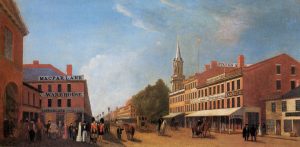
King Street looking West from Jarvis circa 1845 — oil painting by John Gillespie
Although Toronto was ostensibly racially homogeneous, composed of a common English, Scottish and Irish ancestry, its population was nonetheless divided along class, religious and ultimately ethnic lines. Power and politics in colonial Upper Canada, was dominated by a mostly English elite, consisting of representatives of the Crown, government officials and clerks, doctors, architects, bankers, financial officers, teachers, military officers and engineers. Almost all the powerful English were Anglicans. Where one prayed, often reflected how one earned his income. The men who met each other in the boardrooms of the Bank of Upper Canada, tended to worship together at the Church of St. James on the corners of Church and King Streets.[2]
In the simplified model of Toronto’s ethnic composition, the Scottish come next, often representing leading merchants, future manufactures, and publishers—the middle classes of varying wealth
It was the flood of Irish immigrants that was going to put a crack in the placid Toronto status quo. The Irish arrived bitterly divided amongst themselves into Protestant and Catholic camps—and that was before the potato blight made its contribution to the divisions and spilled millions of rural Irish immigrants into the cities of North America.
Added to this volatile mixture in Toronto, would be the figure of the Orange Irish constable.
When it was first incorporated in 1834, the City of Toronto, referred to back then as “the Corporation”, was run as a small oligarchy of local politicians—the Family Compact. It was like a ‘city-state’ within the confines of Upper Canada, almost in the Italian Renaissance-era tradition. The Mayor and Toronto Aldermen, held the positions of Magistrates along with their elected office and commanded the absolute personal loyalty of the Toronto Police. In 1841, a Provincial Commission of Inquiry into politics in Toronto, would report:
We have carefully perused the enactments under which the City of Toronto was originally incorporated… and we find the power thereby conferred on the Civil Magistrates, the very use of which by men of any class, party, or persuasion, could hardly be other than an abuse. The Corporation combines within itself, Legislative, Judicial and Executive functions. It appoints its own officers, remunerates them at discretion, and discharges them at will. It makes its own by-laws, enforces the same by its own Police, and executes them through its own tribunals… In all these cases, the City Police or the City Officers appear to be so closely identified with the Magistrates on the Bench, and the whole machinery of justice so completely monopolized in the same hands, that it would be impossible for the most immaculate body of men in the capacity of Magistrates, to avoid imputations engendered by the doubts, the cavils, and the want of confidence which such a system must infallibly entail.[3]
Toronto City Council retained for itself the formidable power to hire Toronto police officers. Each Alderman had the right to appoint a number of constables in his ward, resulting in a police force hired entirely through a system of political favours. The Toronto police force was partisan, corrupt, and inept. There were no standards of recruitment and no training, and even though uniforms were first issued in 1837, one contemporary recalled that the Toronto Police was “without uniformity, except in one respect—they were uniformly slovenly.”[4]
On March 9, 1835, Toronto retained five fulltime constables—a ratio of about one officer for every 1,850 citizens.[5] Their daily pay was set at 5 shillings for day duty and 7 shillings, 6 pence for night duty—a substantial raise to the 2/6 paid previously to constable conscripts.[6] Constables were appointed for a duration of one year, coinciding with the term of office of the alderman nominating them. The constables’ annual pay was fixed at £75 per annum in 1837, a lucrative City position when compared to the Toronto Mayor’s annual pay of £250.[7]
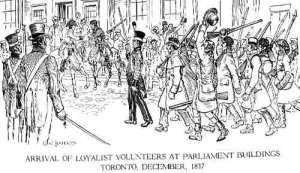
In 1837 there was a rebellion in Toronto led by the city’s former mayor, William Lyon Mackenzie. There are no historical records that reveal what role the Toronto Police played in the suppression of the rebellion which was confronted by the militia while Toronto’s garrison was dealing with events in Kingston. Nonetheless, it is one of those historical paradoxes, that while the rebellion has been unfairly and so far universally dismissed by historians as a farcical comedic opera, its effect would resonate on politics and Toronto police policy for more than a decade to come. It would position the Toronto Police as a touchstone of the struggle between the Provincial-Municipal jurisdictions over the security within the confines of Toronto.
The nature of this jurisdictional conflict became quickly visible when in October 1838, a force of 500 rebels with American supporters launched an incursion into Upper Canada at the Detroit-Windsor frontier. The Lieutenant Governor, speaking for the Province, asked the Mayor to convey a message to Toronto’s City Council that there was “an imminent danger of an immediate invasion of this Province and an attack upon this City by the Rebels and Pirates”.[8] The Mayor told the Council:
I am commanded by His Excellency the Lt Governor to communicate to you that in consequence of information of a conspiracy to invade this Province entered into by a numerous body of foreign Brigands, His Excellency had thought it right to take immediate steps for the protection of the City in anticipation of the employment and organization of an adequate Militia force.[9]Toronto’s Aldermen rejected any Provincial role in organizing its citizens for the defense of Toronto, and responded to the Province:
In the opinion of this Council the most effective mode of seconding the views of the Provincial Government in protecting the city from the consequences of any attack which may be apprehended from the foreign Brigands alluded to in the Communications from His Excellency the Lt Gov to the Mayor yesterday date, will be to increase the strength of the Police force of this City and that therefore ten extra police Constables be forthwith appointed by this Council and that the City Magistrates immediately prepare a code of instructions for the government and guidance of said Police force.[10]With a kind of one-upmanship, the Province responded to the City directly, offering to pay for an additional twelve constables in Toronto, but not without first pointing out the inadequacies of the Toronto Police, and advising the City that the Province via the Lieutenant Governor should approve the new constables:
The Council [Provincial Executive] are fully aware of the necessity which exists for an augmentation of the Police for the City, which at present appears inadequate as well for the purpose of discovering and defeating the machinations of the enemy without the active intervention of the Military…The Council would feel pleased if the City Council previous to making the appointments finally would communicate the names of the proposed constables for your Excellency’s approval.[11]
The Council therefore respectfully recommend to your Excellency to communicate to the Mayor of Toronto that should the City Council think fit to appoint twelve additional Constables, to be employed for such period as Your Excellency may deem necessary, Your Excellency will engage that the necessary increased expenditure will be defrayed by the Government.
Toronto’s cagey alderman did not take long to both accept the offer while at the same time bristling at and rejecting the Province’s attempt to regulate the appointment of the constables. Toronto City Council:
Resolved that this Council relying with every confidence upon the exertions of the Government to protect the public peace and ensure the safety of this Province are induced to believe that it is necessary that this City should be furnished with a Police force greater than in ordinary times would be required.The Council heartily approve of the prompt manner in which the Government have offered to defray the expenses of twelve additional Constables, but relying as they do upon the zeal of the Mayor and Alderman of the City under any circumstances, while on the one hand they express their thanks to the Government for their liberal offer of Twelve additional Constables, which they accept, they conceive that any change in the present system of Police regulations which would interfere with the duties of the Mayor and Aldermen would be inexpedient as well as an infringement of the Act of Incorporation.[12]
The Rebellion of 1837 and the subsequent incursion at Windsor in 1838, would transform the Toronto City Police into a strategic objective in the struggle between the Province and the Municipality. Any “infringement of the Act of Incorporation” by the Province was to be staunchly beaten back by the City for decades. Furthermore, the Rebellion gave a context to the Toronto Police as a defensive force against rebellious external enemies. Later, as we shall see, this function would be refocused towards what were to be perceived as potentially rebellious forces from within the community. Crime fighting itself, was low on the agenda of perceived functions for the Toronto police.
Two principle political factions fought for power in Toronto during this time: the Tories, who represented the entrenched old establishment, and the Reformers, who represented the rising new middle class establishment. Making things more complicated, was the growing presence of a powerful secret society in Toronto: the Orange Order, an ultra-Protestant movement born in the conquest of Ireland and the ensuing conflict between Catholic and Protestant there. Its pro-England, proud trinity of crown, empire, and Protestantism, provided its members an ideological tradition that was reformulated in the context of local Toronto issues.[13]
There were at least twenty-six riots in Toronto between 1839 and 1860. Almost all of these riots involved the Orange Order in some manner.[14] The Toronto Police constables, of which at least half were members of the Order, and all of whom were appointed by mainly Orange supported politicians, would act in not only in favour of the Orange factions in these riots, but sometimes participated in the riots as offenders as well.[15]
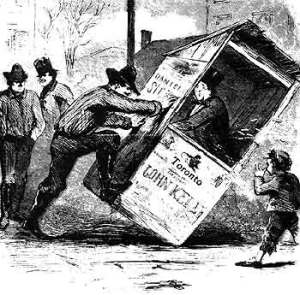 Making
matters worse, incumbent Tory politicians were routinely using the
Toronto Police as a private army to suppress their opposition
Reform candidates. In October 1839, Toronto constables were marshaled to break up a Reformist meeting at ‘Davis’s Temperance Tavern.’ [16] In December 1840, the Reformist paper Examiner trumpeted, “The reign of the present corporation is emphatically one of terror.”[17]
A meeting of a Reformer candidate and supporters at a tavern on Yonge
Street was cancelled when Toronto constables, reinforced with
“specials” armed with clubs, occupied the tavern and dispersed the
meeting.[18]
In the following years, numerous legal political meetings and
Reformer rallies were violently broken up by the Toronto Police, on
orders from incumbent Aldermen. Toronto Police constables would
be personally transported in wagons by Tory aldermen at the reins,
and set loose to attack Reform candidate meetings.[19] The incumbent aldermen had personally nominated each of those Toronto constables to his post.
Making
matters worse, incumbent Tory politicians were routinely using the
Toronto Police as a private army to suppress their opposition
Reform candidates. In October 1839, Toronto constables were marshaled to break up a Reformist meeting at ‘Davis’s Temperance Tavern.’ [16] In December 1840, the Reformist paper Examiner trumpeted, “The reign of the present corporation is emphatically one of terror.”[17]
A meeting of a Reformer candidate and supporters at a tavern on Yonge
Street was cancelled when Toronto constables, reinforced with
“specials” armed with clubs, occupied the tavern and dispersed the
meeting.[18]
In the following years, numerous legal political meetings and
Reformer rallies were violently broken up by the Toronto Police, on
orders from incumbent Aldermen. Toronto Police constables would
be personally transported in wagons by Tory aldermen at the reins,
and set loose to attack Reform candidate meetings.[19] The incumbent aldermen had personally nominated each of those Toronto constables to his post.It was in March 1841, when election violence in Toronto would finally spark a Provincial inquiry into the City and its police. At that time, the Mayor and Chief Magistrate of Toronto was George Monro, a wholesaler, a Tory pew holder at St. James Cathedral, a director in several banks in Upper Canada, and a member of the Orange Order. When Provincial elections were declared, Monro and a compatriot, Henry Sherwood, ran on a Tory ticket for the Toronto seats in the new Parliament. The weight of the Orange Order and the Corporation city machinery was thrown in behind their campaign. To everyone’s surprise however, they lost to the Reform ticket of Dunn and Buchanan.
The day after the election, the Dunn-Buchanan faction decided to stage a victory parade down Church Street, and past the defeated Mayor Monro’s offices in the City Hall which stood on King Street near Church at the time. Near the corner of Church and King, was the Coleraine Tavern, which during the election was kept as an ‘open house’ for Monro’s faction. Several Orange Order Lodges also held their weekly meetings in the Coleraine. Witnesses testifying before the Provincial Commission stated that they saw a group of strangers armed with knives, sticks, and various firearms going in and out of the tavern on the morning of the parade. The investigation later identified these men as members of the Orange Order in Scarborough, brought over in a wagon that morning by the owner of the tavern under the instructions of Samuel Sherwood, Henry’s brother.[20] (We will encounter Samuel again shortly.)
All this was occurring some eighty yards away from Mayor Monro’s office. Several witnesses testified that they ran to Monro asking him to send some constables to the parade route, and for him to go to the Coleraine and calm his supporters down. Monro refused and kept twelve of the twenty special constables hired that day, positioned inside the City Hall. The remaining eight were not to be seen anywhere.[21]
As the parade began to make its way past the Coleraine Tavern it was attacked by rocks and bottles thrown by Monro supporters from inside. Eventually the parade halted and began to threaten to attack the tavern. At that point, a shot was fired from a tavern window, and one of the Dunn-Buchanan supporters was killed. Troops were called out to restore order while the murderer was never identified and the Toronto Police remained conspicuously absent. Charles Dickens who was visiting Toronto during this period later wrote of the events:
One man was killed on the same occasion and from the very window whence he received his death, the very flag which shielded his murderer (not only in the commission of his crime, but from its consequences), was displayed again on the occasion of the public ceremony performed by the Governor General, to which I have just adverted. Of all the colours in the rainbow, there is but one which could be so employed: I need not say that the flag was orange.[22]
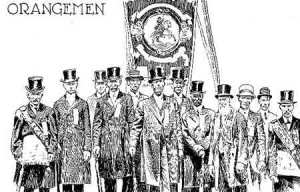
In their report later that year, the Provincial Commission investigating the events and the administration of Toronto began by highly criticizing the efficiency in general of the Toronto Police:
The City of Toronto possesses no Night Watch. The necessity for such an institution is obvious. Within the last 3 weeks, one burglary and robbery to the amount of 1000 pounds has been committed. This burglary was effected in a house immediately opposite to the Police Office, and an iron chest containing the money, removed without observation or subsequent detection.[23]In defense of the Corporation, Charles Daly, the Clerk of the Peace, responded to the accusations. He proceeded to point out that fighting crime was not the main function of the Toronto Police:
It is not their duty as Constables to detect infractions of the Provincial or Civic Laws, or to lay information on breaches of the same. If they witnessed any such infraction, they would be duty bound to mention it to the Magistrates. There is no summary punishment under the Law for resisting the Police in the execution of their duty. There is no Night Watch beyond the two Police Constables on duty during the night. They are appointed by the Corporation and removed by the same body at pleasure. I consider the present Police force adequate for the daily protection and peace of the City; but as far as the prevention of crime and security of property is concerned, I think it be increased with advantage at night. If the increase is made at all to be effective, it must be extensive. I doubt if the increase would be agreeable to the citizens or if they would consider it repaid by the security conferred.[24]
The Provincial Commissioners focused on the system where city aldermen appointed police constables in Toronto. In view of massive testimony about Toronto Police constables attacking opposition party events and workers, and their conspicuous absence during the violence at the Coleraine Tavern, the Inquiry concluded:
It is evident that a force thus constituted must be liable, in times of political excitement, to be employed as political instruments in behalf of those to whom the Corporation or a majority of the Corporation may be friendly. The authority legally invested in these men, their habitual intercourse with the lower classes, the impression that they possess the ear of their employers, the favouritism they may be enabled to suggest, the petty and indirect tyranny they may be permitted to exercise, all combine to degrade a force of this nature into formidable engines of oppression.[25]The Commission further focused on a method of coercion more subtle than the policeman’s baton: liquor licensing. By the time of the 1841 Inquiry, the number of taverns in Toronto licensed to sell liquor or beer was 140; one tavern for every fifty-two Torontonians over the age of sixteen.[26] The administration of liquor licensing was one of the duties of the Toronto Police. Those tavern owners, who did not cooperate with the Tory politicians, soon found that their liquor licenses were not renewed upon expiry. Mixed into this formula, were also all the ‘beer dispensing’ licenses, and unlicensed facilities, which the constables would see fit to handle at their “discretion.” Making matters even worse, some liquor licenses were held by constables themselves.[27]
Numerous witnesses testified how their establishments were denied liquor licenses or had their licenses revoked when they failed to support the Tory party. The Inquiry concluded:
The power of licensing or rather of deciding upon the qualifications of applicants for licenses–a power in the discreet and uncompromising exercise of which so much of public morality and good order depends, will and must be inevitably abused if entrusted, to the caprice of an elective Magistracy. It will be prostituted to seduce the wavering, to reward the compliant, to punish the refractory. The influence exercised by Tavernkeepers at public elections, is notorious, and we feel that the means which the existing Corporation have employed for securing or coercing this influence are sufficient to justify the preceding observations.[28]Toronto’s taverns were the central focus of vote gathering power. Dispensing intoxicants and gathering together a consensus, a tavern in 19th century Toronto, was as powerful a political tool, as television is today. It is for this reason, that the Reform movement took an anti-alcohol stance in its early political platform. By breaking the tavern-based vote-focusing machinery of the Tories, the Reform movement hoped to seize power for itself in future elections. However, once the Reformers aligned themselves with the religious Temperance movement in their bid for power, they found themselves permanently locked into an anti-alcohol platform on moral grounds, rather than political or strategic. It is in these events, that we find the roots of today’s stringent liquor laws in Ontario and the foundation of the future puritanical Toronto the Good.
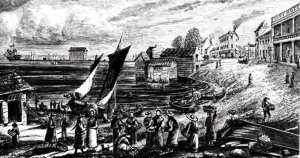
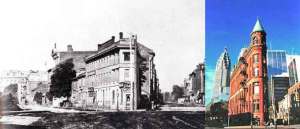 View towards the “Coffin Block” at Front and Church Streets along the shoreline, circa 1845. (top)
View towards the “Coffin Block” at Front and Church Streets along the shoreline, circa 1845. (top)Building seen in sketch still surviving to be photographed in 1873. (above left)
Current “Flatiron Building” built in 1891 on the same site. (above right)
Finally, the Provincial Commission turned its attention to the Orange Order in its Report:
After the report was published, Ontario quickly introduced legislation attempting to suppress the power of the Orange Order and regulate electoral conduct. During elections the exhibiting of party flags and colours was outlawed, as was election bribery and the carrying of firearms. In 1843 the Parliament further introduced the Party Processions Act and the Secret Societies Act, which was aimed at suppressing the Orange Order.[30] (The latter was disallowed by Britain as the Act failed to distinguish the Orange Order from another even more influential but less vitriolic secret society, the Order of Free and Accepted Masons.) But there was nobody to enforce these Acts. Certainly not the Toronto Police, for as Charles Daly testified above, it was “not their duty as Constables to detect infractions of the Provincial or Civic Laws, or to lay information on breaches of the same.”[31]The officers of the Corporation and the Police, are for the most part open and avowed Orangemen. Orangeism has become the watchword and symbol of the party which supports the Corporation, and the most efficient if not the indespensable recommendation to civic favour or employ.At the late Election, Orangeism was the Shibboleth of the Corporation party. At the riots which ensued, Orangemen systematically brought into the City from the surrounding country were the most conspicuous actors…
We cannot, therefore, conclude this Report, without expressing our earnest conviction, that the existence of Orangeism in this Province, is a great and growing evil, which should be discountenanced, denounced, and repressed, by the exercise of every authority and influence at the disposal of the Government.[29]
In 1843 City Council increased Toronto’s police strength to eight permanent constables. Two stations were established where a constable was kept on duty from 8 a.m. to 2 a.m. the next morning. The other constables patrolled in nine hour shifts but no night watch was introduced.[32]
The specter of the 1837 Rebellion reappeared again in Toronto in 1849 with the introduction of the Rebellion Losses Bill and the return to the city of William Lyon Mackenzie. Rioting ensued and the homes of prominent Reformers were attacked, although the mobs stopped short of burning them down. (In Montreal the Parliament building were set on fire.) Once again, the Toronto Police were conspicuously absent while at least two Tory Aldermen led the rioters.[33] Mayor George Gurnett eventually called out the troops to restore order, for which he would be severely criticized by the Toronto City Council.
In 1849 it was approaching ten years since the Election Commission Report, but little was done to remedy the relationship between Toronto’s aldermen and the city’s police constables. The Provincial government was moving very gradually in dismantling Toronto’s city-state administration. In 1849 it introduced the New Municipal Corporations Act, which placed Toronto’s local criminal judiciary—the Police Magistrate’s Court—under the control and pay of the Province.[34] But the Province timidly appointed Toronto’s Mayor, George Gurnett to that position.
Whatever the Province’s ambitions, the fact remained that Toronto was a key source of electoral power in the Provincial Parliament and throughout the 1840s and most of 1850s, Toronto elected Tory, not Reform candidates to the Legislative Assembly. The Province hesitated to force reform on the Toronto Police system, despite the continual abuses. In 1852, matters only became worse: the City appointed Samuel Sherwood as Chief of Police. Samuel was the brother of Henry Sherwood, whose defeat along with Monro had sparked the 1841 election riot. Samuel Sherwood had been implicated during the Provincial inquiry in the organizing of the armed group inside the Coleraine Tavern which opened fire on the passing victory parade.[35] Now in 1852 Sherwood was rewarded with the position of Police Chief of Toronto, an appointment he would hold until 1859.
http://www.russianbooks.org/crime/cph3.htm
Please share this
No comments:
Post a Comment